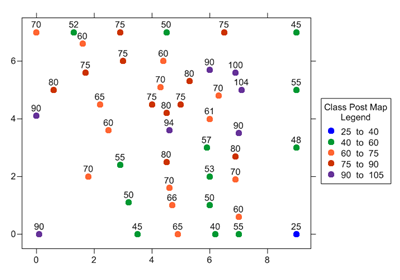Classed Post Map
Classed post maps indicate XY locations with symbols and labels and require Z values in addition to the XY coordinates. Classed post maps group the data into discrete classes (bins). The data points are displayed using the symbol assigned to the class. Classed post maps can also include a legend.
The limits of a classed post map are based on the limits of the X and Y coordinates contained within the associated data file. These limits can be changed if necessary.
|
|
|
This classed post map displays colored symbols and labels. The legend to the right adds information about how the symbols are classed. |
Data Files
Classed post maps are created from data files containing X and Y coordinates. The X and Y coordinates are used to determine the locations for symbols on the post map. A third worksheet column of numbers is used to separate the points into different classes. The data files can contain additional information to post text associated with the point location. To create a classed post map you must first create a data file in the format described in the Data Files Used for Posting topic.
Creating a New Classed Post Map
To create a classed post map:
- Click the Home | New Map | Classed Post command or the
 button.
button. - Select a data file in the Open Data dialog and click Open.
The map is automatically created with reasonable defaults.
If the classed post map does not have any symbols in it, the map may not have the correct worksheet columns specified or may have text instead of numerical values in the worksheet columns. To determine if this is the case, click on the classed post map to select it. In the Properties window, click on the General tab. Open the Worksheet Columns section, if necessary. Adjust the X coordinates and Y coordinates columns. If the columns are specified correctly, check the data file to verify that the columns contain numeric data. If the data columns are correct, the class post map limits may be incorrect, preventing the data from being displayed. Click on the Map in the Contents window to select it. Check the values on the Limits tab.
Editing an Existing Classed Post Map
To change the features of the classed post map, click once on the classed post map in either the plot window or the Contents window. The properties are displayed in the Properties window.
Loading and Saving Classed Post Map Class .CLS Files
Surfer has the ability to load or save a classed post map's color and symbol class definitions. To load an existing class file, click on the post map to select it. In the Properties window, click on the Classes tab. Click the Edit Classes button to open the dialog where you can set the class properties. Click the Load button to import the information from an existing class file. To save the information to a new .CLS class file, click the Save button.
Adding a Map Layer
When classed post maps are created, they are independent of other maps in the plot window. For example, creating a classed post map while a contour map is present in the plot window yields two separate maps, each with its own set of axes and scaling parameters. To create a single map with the classed post map data points on the contour map, select both maps by clicking the Select All command. Overlay the maps using the Map Tools | Map Tools | Overlay Maps command.
Alternatively, you can add the classed post map directly to the existing contour map by creating the classed post map using the Home | Add to Map | Layer | Classed Post or Map Tools | Add to Map | Layer | Classed Post command. This automatically adds the classed post map to the contour map axes.
Another alternative, is to create both maps using the Home | New Map commands. Then, select one map and drag the map layer to the other map object. This is equivalent to using the Overlay Maps command to overlay maps. For example, create a contour map with the Home | New Map | Contour command. Create the classed post map using the Home | New Map | Post | Classed Post command. This creates two separate maps. Click on the classed post map, hold down the left mouse button, and drag the classed post map into the contour map. A single map with two map layers, using one set of axes and scaling parameters is created.
You can combine any number of classed post maps with any other map.
Classed Post Layer Properties
The classed post layer properties contains the following pages:
Map Properties
The map properties contains the following pages:
See Also
Updating Post Maps and Classed Post Maps
